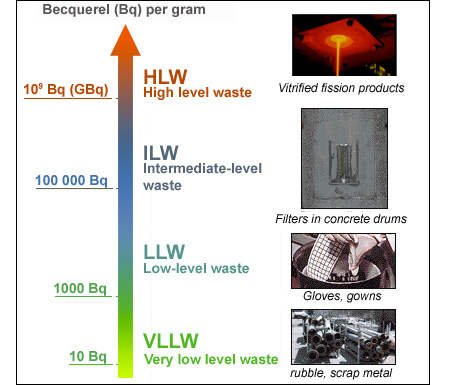Drawing up an inventory of radioactive materials
Radioactive materials are very varied. They differ in terms of their physical and chemical properties, the intensity and nature of the radiation they emit, and the risks they entail. The vast amounts of scrap from uranium mines, which release a small amount of radon, have almost nothing in common with the vitrified residues from La Hague. The management of each category of waste has to suit the characteristics of that waste. For waste to be managed properly, a complete inventory of it has to be drawn up.
For the purposes of management, the inventory is based on two classification criteria:
– The activity level, which determines the protection measures to be taken. The categories are: very low-level waste (VLLW), low-level waste (LLW), intermediate-level waste (ILW), or high-level waste (HLW);
– The length of life of the main radioactive elements present, which determines the duration of the protection to be considered. Radioelements with a half life of less than 31 years are known as short-lived (SL). It’s all relative! Others are known as long-lived (LL).
of less than 31 years are known as short-lived (SL). It’s all relative! Others are known as long-lived (LL).
There is also very short-lived waste (VSLW), a significant share of which comes from the medical applications of radioactivity (diagnostics or treatment). The radioelements in this kind of waste have half lives of less than 100 days. They naturally disappear very rapidly. Managing very short-lived waste consists merely of waiting the necessary length of time.

First criterion: activity level
The activity level of waste is defined by the number of disintegrations per second (becquerels) occurring in a gram of material. Activity and radiological risk vary greatly. Between the barely radioactive scrap metal and rubble in very low-level waste and the molten glass at La Hague there is a factor of 100 million.
© ANDRA
The waste presenting the lowest risk is very low-level waste (VLLW) or low-level short-lived waste (LLW-SL). Not only are the volumes of this waste by far the largest, but the waste is also industrially managed. At the opposite end of the spectrum there is high-level waste from reactors. Here almost all the radioactivity is concentrated in a small volume. Generally speaking, the greater the volume for a particular waste category, the lower the activity and risks.
Highly radioactive materials from spent fuel from reactors have to be managed as a priority. Naturally the largest producers are companies that generate electricity. While in operation, reactors only release a minute quantity of radioactivity into the environment thanks to the abundance of precautions taken. The same standard must be maintained when the irradiated fuel is unloaded from the reactor core. This is a relatively easy task over several decades, but it is a challenge that has to be met on a scale of centuries.

Two criteria for classifying waste
Radioactive waste areclassified according to the level of activity and lifetime – short or long – of its main elements. For low (VLLW) and very low-level (VLLW) categories no distinction is made between short- and long-lived waste. Research is being conducted into the management of the two long lived intermediate (ILW-LL) and high level activity (HLW) waste. Research into these two major categories, in which nearly 99% of radioactivity is concentrated, is organised in France in accordance with the Bataille Act of 30 December 1991.
© ANDRA
However much of a priority it may be, the radioactive material produced by reactors is not the only radioactive waste that has to be managed. A complete inventory must also include other waste from the nuclear cycle, waste from military nuclear (generally kept secret), and waste generated by industry, hospitals and laboratories. There is also legacy waste that has not yet been dealt with and future waste that has not yet had to be dealt with, such as the waste that will come from dismantling plants that are currently still in operation.
Articles on the subject « Waste Inventory »
France: waste panorama (1)
An overview of French waste categories… In France, radioactive waste is split into five cat[...]
France: waste panorama (2)
An overview of French waste categories (continued)… Low- and intermediate-level short-lived[...]
US panorama
The case of the greatest nuclear power Nuclear-powered US Navy vessels, past production of nuclea[...]
Various radioactive waste
Radioactive waste from many different sources… When radioactive waste is mentioned, people [...]
Mining residues
Waste from uranium extraction The residues from processing uranium ores are disposed of on the si[...]
Medicine and research
Radioactive sources, producers of waste outside the nuclear industry… Biology labora[...]
Military waste
A separate system Using the gaseous diffusion process, the AREVA Pierrelatte facility produced en[...]
Radium-bearing waste
Legacy waste – weakly radioactive but long-lived Recent and less recent industrial activities hav[...]
Waste from Dismantling
Dismantling of facilities: graphite waste Experience with dismantling nuclear power plants is onl[...]
Waste from Industry
Obsolete radioactive sources, the legacy of radium applications There are numerous industrial app[...]